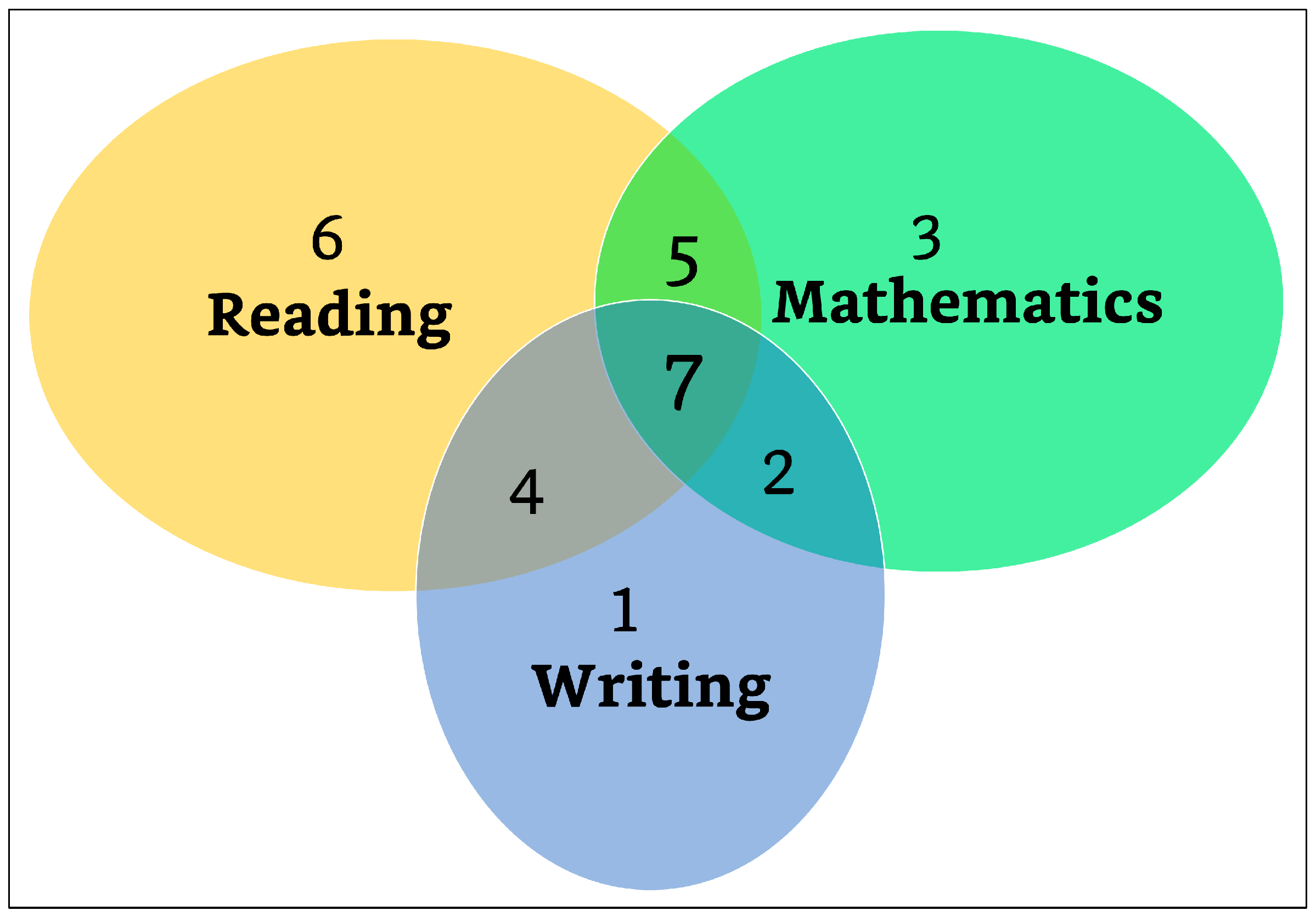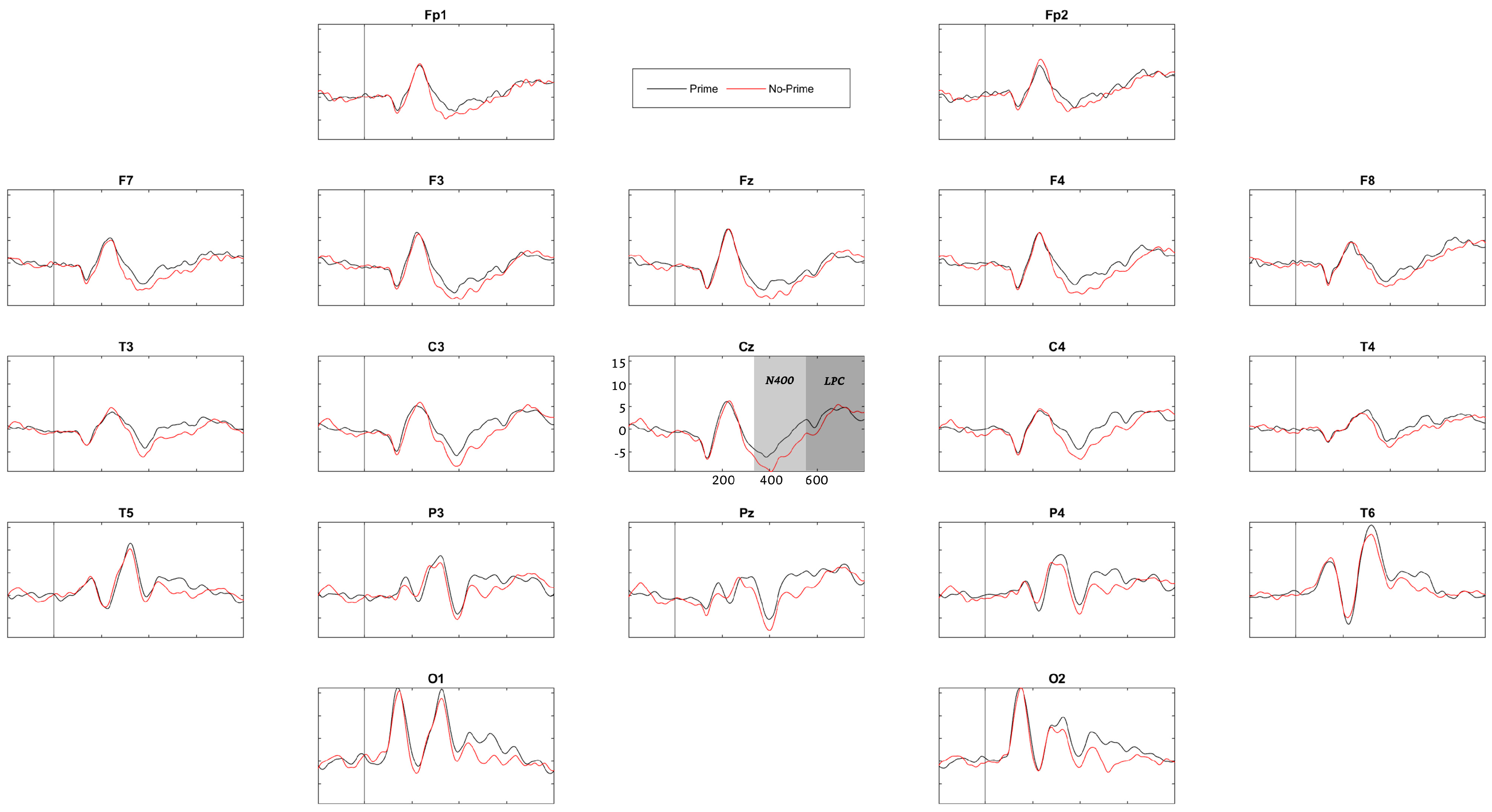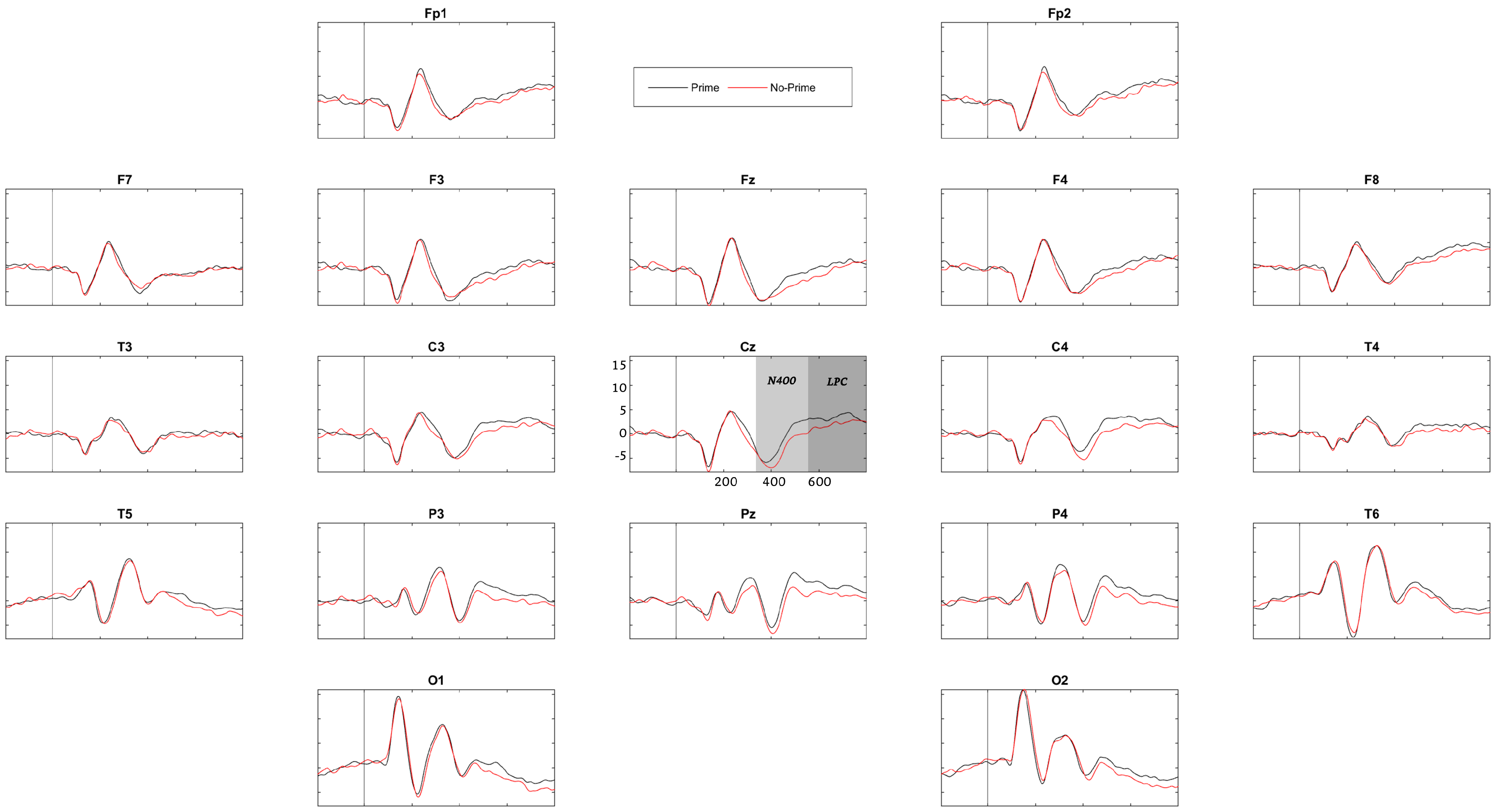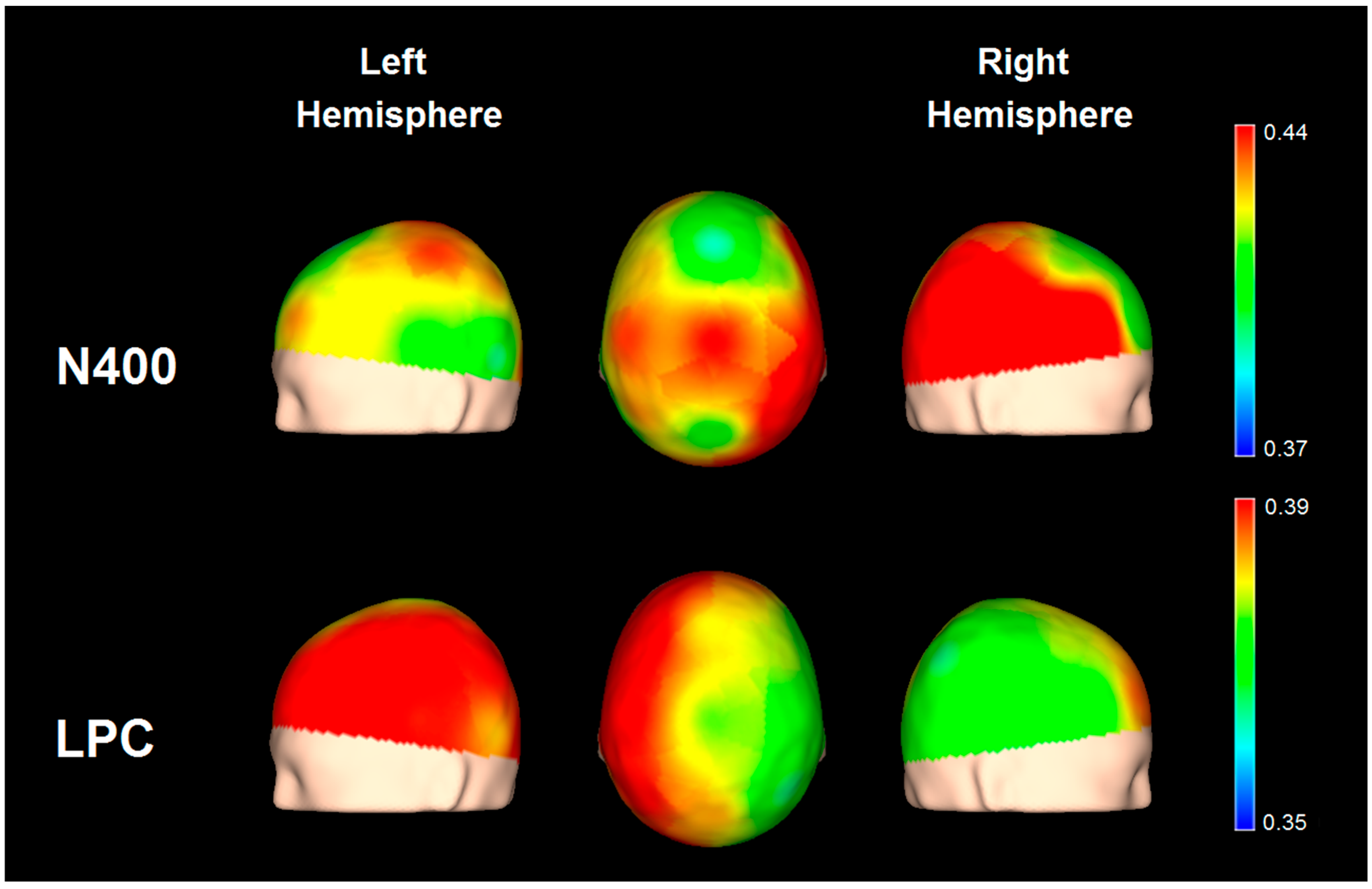Semantic Priming and Its Link to Verbal Comprehension and Working Memory in Children with Learning Disorders
Abstract
1. Introduction
2. Materials and Methods
2.1. Participants
2.2. Indices of the WISC-IV Scale
- Verbal Comprehension Index: Measures a child’s verbal abilities, such as vocabulary, comprehension, and general knowledge. The subtests that support this index are Similarities, Vocabulary, and Comprehension.
- Perceptual Reasoning Index: Measures a child’s nonverbal reasoning abilities, such as visual–spatial skills, perceptual organization, and problem solving. The subtests that support this index are Block Design, Picture Concepts, and Matrix Reasoning.
- Working Memory Index: Measures a child’s working memory ability, i.e., the capacity to hold and manipulate information for short periods of time. The subtests that support this index are Digit Span and Letter–Number Sequencing.
- Processing Speed Index: Measures a child’s processing speed abilities, such as the speed of performing simple tasks. The subtests that support this index are Coding and Symbol Search.
2.3. Lexical Decision Task and ERP Acquisition
2.4. Statistical Analysis
3. Results
3.1. Cognitive Performance and Behavioral Results of the Lexical Decision Task
3.2. ERP Results: Within-Condition and Between-Group Comparisons
3.3. Relationship between Cognitive Performance and the N400 Effect in the LD Group
4. Discussion
5. Conclusions
Author Contributions
Funding
Institutional Review Board Statement
Informed Consent Statement
Data Availability Statement
Acknowledgments
Conflicts of Interest
References
- American Psychiatric Association. Diagnostic and Statistical Manual of Mental Disorders: DSM-5-TR; American Psychiatric Association Publishing: Washington, DC, USA, 2022. [Google Scholar]
- American Psychiatric Association. Diagnostic and Statistical Manual of Mental Disorders, 4th ed.; American Psychiatric Association Publishing: Washington, DC, USA, 2000; Volume 1, 943p. [Google Scholar] [CrossRef]
- Altarac, M.; Saroha, E. Lifetime Prevalence of Learning Disability Among US Children. Pediatrics 2007, 119 (Suppl. S1), S77–S83. [Google Scholar] [CrossRef] [PubMed]
- Lagae, L. Learning Disabilities: Definitions, Epidemiology, Diagnosis, and Intervention Strategies. Pediatr. Clin. N. Am. 2008, 55, 1259–1268. [Google Scholar] [CrossRef] [PubMed]
- Shaywitz, S.E.; Fletcher, J.M.; Holahan, J.M.; Shneider, A.E.; Marchione, K.E.; Stuebing, K.K.; Francis, D.J.; Pugh, K.R.; Shaywitz, B.A. Persistence of Dyslexia: The Connecticut Longitudinal Study at Adolescence. Pediatrics 1999, 104, 1351–1359. [Google Scholar] [CrossRef]
- Willcutt, E.G.; Petrill, S.A.; Wu, S.; Boada, R.; DeFries, J.C.; Olson, R.K.; Pennington, B.F. Comorbidity Between Reading Disability and Math Disability: Concurrent Psychopathology, Functional Impairment, and Neuropsychological Functioning. J. Learn. Disabil. 2013, 46, 500–516. [Google Scholar] [CrossRef]
- Semrud-Clikeman, M. Neuropsychological Aspects for Evaluating Learning Disabilities. Commun. Disord. Q. 2005, 26, 242–247. [Google Scholar] [CrossRef]
- Johnson, E.S.; Humphrey, M.; Mellara, D.F.; Woods, K.; Swanson, H.L. Cognitive Processing Deficits and Students with Specific Learning Disabilities: A Selective Meta-Analysis of the Literature. Learn. Disabil. Q. 2010, 33, 3–18. [Google Scholar] [CrossRef]
- Schuchardt, K.; Bockmann, A.-K.; Bornemann, G.; Maehler, C. Working Memory Functioning in Children With Learning Disorders and Specific Language Impairment. Top. Lang. Disord. 2013, 33, 298–312. [Google Scholar] [CrossRef]
- De Weerdt, F.; Desoete, A.; Roeyers, H. Working Memory in Children with Reading Disabilities and/or Mathematical Disabilities. J. Learn. Disabil. 2013, 46, 461–472. [Google Scholar] [CrossRef]
- Alloway, T.P. Working Memory, but Not IQ, Predicts Subsequent Learning in Children with Learning Difficulties. Eur. J. Psychol. Assess. 2009, 25, 92–98. [Google Scholar] [CrossRef]
- Peng, P.; Barnes, M.; Wang, C.C.; Wang, W.; Li, S.; Swanson, H.L.; Dardick, W.; Tao, S. Meta-Analysis on the Relation between Reading and Working Memory. Psychol. Bull. 2018, 144, 48. [Google Scholar] [CrossRef]
- Swanson, H.L. Specific Learning Disabilities as a Working Memory Deficit. In Handbook of Educational Psychology and Students with Special Needs; Routledge: London, UK, 2020. [Google Scholar] [CrossRef]
- Fonseca, L.C.; Tedrus, G.M.A.S.; Chiodi, M.G.; Cerqueira, J.N.; Tonelotto, J.M.F. Quantitative EEG in Children with Learning Disabilities: Analysis of Band Power. Arq. Neuropsiquiatr. 2006, 64, 376–381. [Google Scholar] [CrossRef] [PubMed]
- Chabot, R.J.; di Michele, F.; Prichep, L.; John, E.R. The Clinical Role of Computerized EEG in the Evaluation and Treatment of Learning and Attention Disorders in Children and Adolescents. J. Neuropsychiatry Clin. Neurosci. 2001, 13, 171–186. [Google Scholar] [CrossRef] [PubMed]
- Fernández, T.; Harmony, T.; Fernández-Bouzas, A.; Silva, J.; Herrera, W.; Santiago-Rodríguez, E.; Sánchez, L. Sources of EEG Activity in Learning Disabled Children. Clin. EEG Neurosci. 2002, 33, 160–164. [Google Scholar] [CrossRef] [PubMed]
- Sternberg, B.S. Memory-Scanning: Mental Processes Revealed by Reaction-Time Experiments. Am. Sci. 1969, 57, 421–457. [Google Scholar] [PubMed]
- Fernandez, T.; Harmony, T.; Gersenowies, J.; Silva-Pereyra, J.; Fernández-Bouzas, A.; Galán, L.; Díaz-Comas, L. Sources of EEG Activity during a Verbal Working Memory Task in Adults and Children. Suppl. Clin. Neurophysiol. 2002, 54, 269–283. [Google Scholar]
- Martínez-Briones, B.J.; Fernández-Harmony, T.; Gómez, N.G.; Biscay-Lirio, R.J.; Bosch-Bayard, J. Working Memory in Children with Learning Disorders: An EEG Power Spectrum Analysis. Brain Sci. 2020, 10, 817. [Google Scholar] [CrossRef]
- Harmony, T. The Functional Significance of Delta Oscillations in Cognitive Processing. Front. Integr. Neurosci. 2013, 7, 83. [Google Scholar] [CrossRef]
- Schapkin, S.A.; Raggatz, J.; Hillmert, M.; Böckelmann, I. EEG Correlates of Cognitive Load in a Multiple Choice Reaction Task. Acta Neurobiol. Exp. 2020, 80, 76–89. [Google Scholar] [CrossRef]
- Dimitriadis, S.I.; Laskaris, N.A.; Tsirka, V.; Vourkas, M.; Micheloyannis, S. What Does Delta Band Tell Us about Cognitive Processes: A Mental Calculation Study. Neurosci. Lett. 2010, 483, 11–15. [Google Scholar] [CrossRef]
- Gevins, A.; Smith, M.E.; McEvoy, L.; Yu, D. High-Resolution EEG Mapping of Cortical Activation Related to Working Memory: Effects of Task Difficulty, Type of Processing, and Practice. Cereb. Cortex 1997, 7, 374–385. [Google Scholar] [CrossRef]
- Maurer, U.; Brem, S.; Liechti, M.; Maurizio, S.; Michels, L.; Brandeis, D. Frontal Midline Theta Reflects Individual Task Performance in a Working Memory Task. Brain Topogr. 2015, 28, 127–134. [Google Scholar] [CrossRef] [PubMed]
- Jokisch, D.; Jensen, O. Modulation of Gamma and Alpha Activity during a Working Memory Task Engaging the Dorsal or Ventral Stream. J. Neurosci. 2007, 2, 3244–3251. [Google Scholar] [CrossRef]
- Jensen, O.; Kaiser, J.; Lachaux, J.P. Human Gamma-Frequency Oscillations Associated with Attention and Memory. Trends Neurosci. 2007, 30, 317–324. [Google Scholar] [CrossRef] [PubMed]
- Honkanen, R.; Rouhinen, S.; Wang, S.H.; Palva, J.M.; Palva, S. Gamma Oscillations Underlie the Maintenance of Feature-Specific Information and the Contents of Visual Working Memory. Cereb. Cortex 2015, 25, 3788–3801. [Google Scholar] [CrossRef] [PubMed]
- Luck, S.J.; Kappenman, E.S. Electroencephalography and Event-Related Brain Potentials; Cambridge University Press: Cambridge, UK, 2017. [Google Scholar]
- Silva-Pereyra, J.; Fernández, T.; Harmony, T.; Bernal, J.; Galán, L.; Díaz-Comas, L.; Fernández-Bouzas, A.; Yáñez, G.; Rivera-Gaxiola, M.; Rodríguez, M.; et al. Delayed P300 during Sternberg and Color Discrimination Tasks in Poor Readers. Int. J. Psychophysiol. 2001, 40, 17–32. [Google Scholar] [CrossRef] [PubMed]
- Cárdenas, S.Y.; Silva-Pereyra, J.; Prieto-Corona, B.; Castro-Chavira, S.A.; Fernández, T. Arithmetic Processing in Children with Dyscalculia: An Event-Related Potential Study. PeerJ 2021, 9, e10489. [Google Scholar] [CrossRef]
- Soltész, F.; Szucs, D.; Dékány, J.; Márkus, A.; Csépe, V. A Combined Event-Related Potential and Neuropsychological Investigation of Developmental Dyscalculia. Neurosci. Lett. 2007, 417, 181–186. [Google Scholar] [CrossRef]
- Fernández, T.; Silva-Pereyra, J.; Prieto-Corona, B.; Rodríguez Camacho, M.; Reynoso-Alcántara, V. Event-Related Brain Potentials during a Semantic Priming Task in Children with Learning Disabilities Not Otherwise Specified. PLoS ONE 2014, 9, e0105318. [Google Scholar] [CrossRef]
- Jednoróg, K.; Marchewka, A.; Tacikowski, P.; Grabowska, A. Implicit Phonological and Semantic Processing in Children with Developmental Dyslexia: Evidence from Event-Related Potentials. Neuropsychologia 2010, 48, 2447–2457. [Google Scholar] [CrossRef]
- Diniz, J.; Mangabeira-Albernaz, P.L.; Lei Munhoz, M.S.; Fukuda, Y. Cognitive Potentials in Children with Learning Disabilities. Acta Oto-Laryngol. 1997, 117, 211–213. [Google Scholar] [CrossRef] [PubMed]
- Niedeggen, M.; Rösler, F.; Jost, K. Processing of Incongruous Mental Calculation Problems: Evidence for an Arithmetic N400 Effect. Psychophysiology 1999, 36, 307–324. [Google Scholar] [CrossRef] [PubMed]
- Prieto-Corona, B.; Rodríguez-Camacho, M.; Silva-Pereyra, J.; Marosi, E.; Fernández, T.; Guerrero, V. Event-Related Potentials Findings Differ between Children and Adults during Arithmetic-Fact Retrieval. Neurosci. Lett. 2010, 468, 220–224. [Google Scholar] [CrossRef] [PubMed]
- Szucs, D.; Soltész, F. Event-Related Brain Potentials to Violations of Arithmetic Syntax Represented by Place Value Structure. Biol. Psychol. 2010, 84, 354–367. [Google Scholar] [CrossRef] [PubMed]
- Núñez-Peña, M.I.; Suárez-Pellicioni, M. Processing False Solutions in Additions: Differences between High- and Lower-Skilled Arithmetic Problem-Solvers. Exp. Brain Res. 2012, 218, 655–663. [Google Scholar] [CrossRef] [PubMed]
- Kutas, M.; Federmeier, K.D. Thirty Years and Counting: Finding Meaning in the N400 Component of the Event-Related Brain Potential (ERP). Annu. Rev. Psychol. 2011, 62, 621–647. [Google Scholar] [CrossRef]
- Brothers, T.; Wlotko, E.W.; Warnke, L.; Kuperberg, G.R. Going the Extra Mile: Effects of Discourse Context on Two Late Positivities During Language Comprehension. Neurobiol. Lang. 2020, 1, 135–160. [Google Scholar] [CrossRef]
- Stelmack, R.M.; Miles, J. The Effect of Picture Priming on Event-Related Potentials of Normal and Disabled Readers during a Word Recognition Memory Task. J. Clin. Exp. Neuropsychol. 1990, 12, 887–903. [Google Scholar] [CrossRef]
- Kojima, T.; Kaga, K. Auditory Lexical-Semantic Processing Impairments in Aphasic Patients Reflected in Event-Related Potentials (N400). Auris Nasus Larynx 2003, 30, 369–378. [Google Scholar] [CrossRef]
- Bouaffre, S.; Faïta-Ainseba, F. Hemispheric Differences in the Time-Course of Semantic Priming Processes: Evidence from Event-Related Potentials (ERPs). Brain Cogn. 2007, 63, 92–93. [Google Scholar] [CrossRef]
- Miles, J.; Stelmack, R.M. Learning Disability Subtypes and the Effects of Auditory and Visual Priming on Visual Event-Related Potentials to Words. J. Clin. Exp. Neuropsychol. 1994, 16, 43–64. [Google Scholar] [CrossRef]
- Zelazo, P.D.; Blair, C.B.; Willoughby, M. Executive Function: Implications for Education. NCER 2017-2000; National Center for Education Research: Alachua, FL, USA, 2016.
- Wechsler, D. WISC-IV, Escala de Inteligencia de Wechsler Para Niños-IV; Manual Técnico y de Interpretación; Publicaciones de Psicología Aplicada; TEA Ediciones: Madrid, Spain, 2010. [Google Scholar]
- Düzenli-Öztürk, S.; Hünerli-Gündüz, D.; Emek-Savaş, D.D.; Olichney, J.; Yener, G.G.; Ergenç, H.İ. Taxonomically-Related Word Pairs Evoke Both N400 and LPC at Long SOA in Turkish. J. Psycholinguist. Res. 2022, 51, 1431–1451. [Google Scholar] [CrossRef]
- Kiefer, M.; Martens, U. Attentional Sensitization of Unconscious Cognition: Task Sets Modulate Subsequent Masked Semantic Priming. J. Exp. Psychol. Gen. 2010, 139, 464–489. [Google Scholar] [CrossRef]
- Yang, H.; Laforge, G.; Stojanoski, B.; Nichols, E.S.; McRae, K.; Köhler, S. Late Positive Complex in Event-Related Potentials Tracks Memory Signals When They Are Decision Relevant. Sci. Rep. 2019, 9, 9469. [Google Scholar] [CrossRef]
- Association, W.M. World Medical Association Declaration of Helsinki: Ethical Principles for Medical Research Involving Human Subjects. JAMA 2013, 310, 2191–2194. [Google Scholar]
- Matute, E.; Inozemtseva, O.; Gonzalez, A.L.; Chamorro, Y. La Evaluación Neuropsicológica Infantil (ENI): Historia y Fundamentos Teóricos de Su Validación, Un Acercamiento Práctico a Su Uso y Valor Diagnóstico. Rev. Neuropsicol. Neuropsiquiatría Neurocienc. 2014, 14, 68–95. [Google Scholar]
- American Psychiatric Association. Diagnostic and Statistical Manual of Mental Disorders, 5th ed.; American Psychiatric Association Publishing: Washington, DC, USA, 2013. [Google Scholar] [CrossRef]
- Andersson, U.; Lyxell, B. Working Memory Deficit in Children with Mathematical Difficulties: A General or Specific Deficit? J. Exp. Child Psychol. 2007, 96, 197–228. [Google Scholar] [CrossRef] [PubMed]
- Jeffries, S.; Everatt, J. Working Memory: Its Role in Dyslexia and Other Specific Learning Difficulties. Dyslexia 2004, 10, 196–214. [Google Scholar] [CrossRef] [PubMed]
- Silva-Pereyra, J.; Rivera-Gaxiola, M.; Aubert, E.; Bosch, J.; Galán, L.; Salazar, A. N400 during Lexical Decision Tasks: A Current Source Localization Study. Clin. Neurophysiol. 2003, 114, 2469–2486. [Google Scholar] [CrossRef]
- Zar, J.H. Biostatistical Analysis; Pearson New International Edition; Pearson Education: London, UK, 2013. [Google Scholar]
- Delorme, A.; Makeig, S. EEGLAB: An Open Source Toolbox for Analysis of Single-Trial EEG Dynamics Including Independent Component Analysis. J. Neurosci. Methods 2004, 134, 9–21. [Google Scholar] [CrossRef]
- Makeig, S.; Bell, A.J.; Jung, T.; Sejnowski, T.J. Independent Component Analysis of Electroencephalographic Data. In Advances in Neural Information Processing Systems 8; Massachusetts Institute of Technology Press: Cambridge, MA, USA, 1996. [Google Scholar]
- Pascual-Marqui, R.D.; Lehmann, D.; Koukkou, M.; Kochi, K.; Anderer, P.; Saletu, B.; Tanaka, H.; Hirata, K.; John, E.R.; Prichep, L.; et al. Assessing Interactions in the Brain with Exact Low-Resolution Electromagnetic Tomography. Philos. Trans. R. Soc. A Math. Phys. Eng. Sci. 2011, 369, 3768–3784. [Google Scholar] [CrossRef]
- Nichols, T.E.; Holmes, A.P. Nonparametric Permutation Tests for {PET} Functional Neuroimaging Experiments: A Primer with Examples. Hum. Brain Mapp. 2001, 15, 1–25. [Google Scholar] [CrossRef] [PubMed]
- Roca-Stappung, M.; Fernández, T.; Becerra, J.; Mendoza-Montoya, O.; Espino, M.; Harmony, T. Healthy Aging: Relationship between Quantitative Electroencephalogram and Cognition. Neurosci. Lett. 2012, 510, 115–120. [Google Scholar] [CrossRef] [PubMed]
- Silva, P.B.; Oliveira, D.G.; Cardoso, A.D.; Laurence, P.G.; Boggio, P.S.; Macedo, E.C. Event-Related Potential and Lexical Decision Task in Dyslexic Adults: Lexical and Lateralization Effects. Front. Psychol. 2022, 13, 852219. [Google Scholar] [CrossRef]
- Gathercole, S.E.; Alloway, T.P.; Willis, C.; Adams, A.M. Working Memory in Children with Reading Disabilities. J. Exp. Child Psychol. 2006, 93, 265–281. [Google Scholar] [CrossRef] [PubMed]
- Bosch-Bayard, J.; Peluso, V.; Galan, L.; Sosa, P.V.; Chiarenza, G.A. Clinical and Electrophysiological Differences between Subjects with Dysphonetic Dyslexia and Non-Specific Reading Delay. Brain Sci. 2018, 8, 172. [Google Scholar] [CrossRef]
- Rogala, J.; Kublik, E.; Krauz, R.; Wróbel, A. Resting-State EEG Activity Predicts Frontoparietal Network Reconfiguration and Improved Attentional Performance. Sci. Rep. 2020, 10, 5064. [Google Scholar] [CrossRef]
- Chow, R.; Rabi, R.; Paracha, S.; Hasher, L.; Anderson, N.D.; Alain, C. Default Mode Network and Neural Phase Synchronization in Healthy Aging: A Resting State EEG Study. Neuroscience 2022, 485, 116–128. [Google Scholar] [CrossRef]
- Ferrari-Díaz, M.; Bravo-Chávez, R.I.; Silva-Pereyra, J.; Fernández, T.; García-Peña, C.; Rodríguez-Camacho, M. Verbal Intelligence and Leisure Activities Are Associated with Cognitive Performance and Resting-State Electroencephalogram. Front. Aging Neurosci. 2022, 14, 921518. [Google Scholar] [CrossRef]





| Control Group n = 12 Mean (SD) | LD Group n = 28 Mean (SD) | t | p | |
|---|---|---|---|---|
| Age | 9.08 (0.79) | 9.11 (0.79) | −0.09 | NS |
| WISC-IV: Full-Scale IQ | 108.92 (10.57) | 91.64 (11.24) | 4.65 | <0.001 |
| Reading | 67.31 (11) | 30.98 (20.21) | 5.99 | <0.001 |
| Writing | 72.22 (11.16) | 42 (17.48) | 5.65 | <0.001 |
| Mathematics | 71.67 (6.85) | 36.11 (21.30) | 5.77 | <0.001 |
| Control Group n = 12 Mean (SD) | LD Group n = 28 Mean (SD) | t | p | |
|---|---|---|---|---|
| Verbal Comprehension | 115.75 (16.62) | 90.39 (10.86) | 5.89 | <0.001 |
| Perceptual Reasoning | 106.92 (13.78) | 97.43 (14.13) | 2.01 | NS |
| Working Memory | 103.50 (8.67) | 93.14 (12.20) | 2.72 | 0.026 |
| Processing Speed | 95.25 (12.40) | 92.21 (12.32) | 0.73 | NS |
| Variable | Group | Mean Primed (SD) | Mean Non-Primed (SD) | t | p |
|---|---|---|---|---|---|
| Correct Responses (%) | Control | 94.04 (4.87) | 92.39 (5.14) | −1.97 | 0.037 |
| LD | 88.92 (7.23) | 87.48 (7.23) | −1.12 | NS | |
| Response Times (ms) | Control | 757.17 (131.29) | 826.58 (172.50) | 3.33 | 0.001 |
| LD | 814.36 (162.15) | 865.96 (161.53) | 3.79 | <0.001 |
| Subcomponent | Statistics | VC | PR | WM | PS |
|---|---|---|---|---|---|
| N400 Effect | Range of r2 values | [0.154, 0.221] | [0.089, 0.118] | [0.014, 0.038] | [0.005, 0.016] |
| Range of slope values | [0.101, 0.128] | [0.062, 0.069] | [0.028, 0.047] | [0.015, 0.031] | |
| p | <0.027 | NS | NS | NS | |
| LPC Effect | Range of r2 values | [0.133, 0.161] | [0.063, 0.094] | [0.017, 0.038] | [0.073, 0.096] |
| Range of slope values | [0.087, 0.098] | [0.046, 0.057] | [0.028, 0.042] | [0.057, 0.067] | |
| p | <0.042 | NS | NS | NS |
Disclaimer/Publisher’s Note: The statements, opinions and data contained in all publications are solely those of the individual author(s) and contributor(s) and not of MDPI and/or the editor(s). MDPI and/or the editor(s) disclaim responsibility for any injury to people or property resulting from any ideas, methods, instructions or products referred to in the content. |
© 2023 by the authors. Licensee MDPI, Basel, Switzerland. This article is an open access article distributed under the terms and conditions of the Creative Commons Attribution (CC BY) license (https://creativecommons.org/licenses/by/4.0/).
Share and Cite
Martínez-Briones, B.J.; Fernández, T.; Silva-Pereyra, J. Semantic Priming and Its Link to Verbal Comprehension and Working Memory in Children with Learning Disorders. Brain Sci. 2023, 13, 1022. https://doi.org/10.3390/brainsci13071022
Martínez-Briones BJ, Fernández T, Silva-Pereyra J. Semantic Priming and Its Link to Verbal Comprehension and Working Memory in Children with Learning Disorders. Brain Sciences. 2023; 13(7):1022. https://doi.org/10.3390/brainsci13071022
Chicago/Turabian StyleMartínez-Briones, Benito Javier, Thalía Fernández, and Juan Silva-Pereyra. 2023. "Semantic Priming and Its Link to Verbal Comprehension and Working Memory in Children with Learning Disorders" Brain Sciences 13, no. 7: 1022. https://doi.org/10.3390/brainsci13071022
APA StyleMartínez-Briones, B. J., Fernández, T., & Silva-Pereyra, J. (2023). Semantic Priming and Its Link to Verbal Comprehension and Working Memory in Children with Learning Disorders. Brain Sciences, 13(7), 1022. https://doi.org/10.3390/brainsci13071022







